Let’s be real: the heart of your home deserves personality—not a sterile catalog vibe. If you’re dreaming of a kitchen that’s warm, lived-in, and charming without trying too hard, rustic farmhouse is your sweet spot. Think cozy textures, worn woods, and those “did you get this at a market in Provence?” moments.
Ready to make it happen? Here are 6 rustic farmhouse kitchen tips that bring instant soul without sacrificing function.
1. Mix Woods Like a Designer (But Keep It Cohesive)
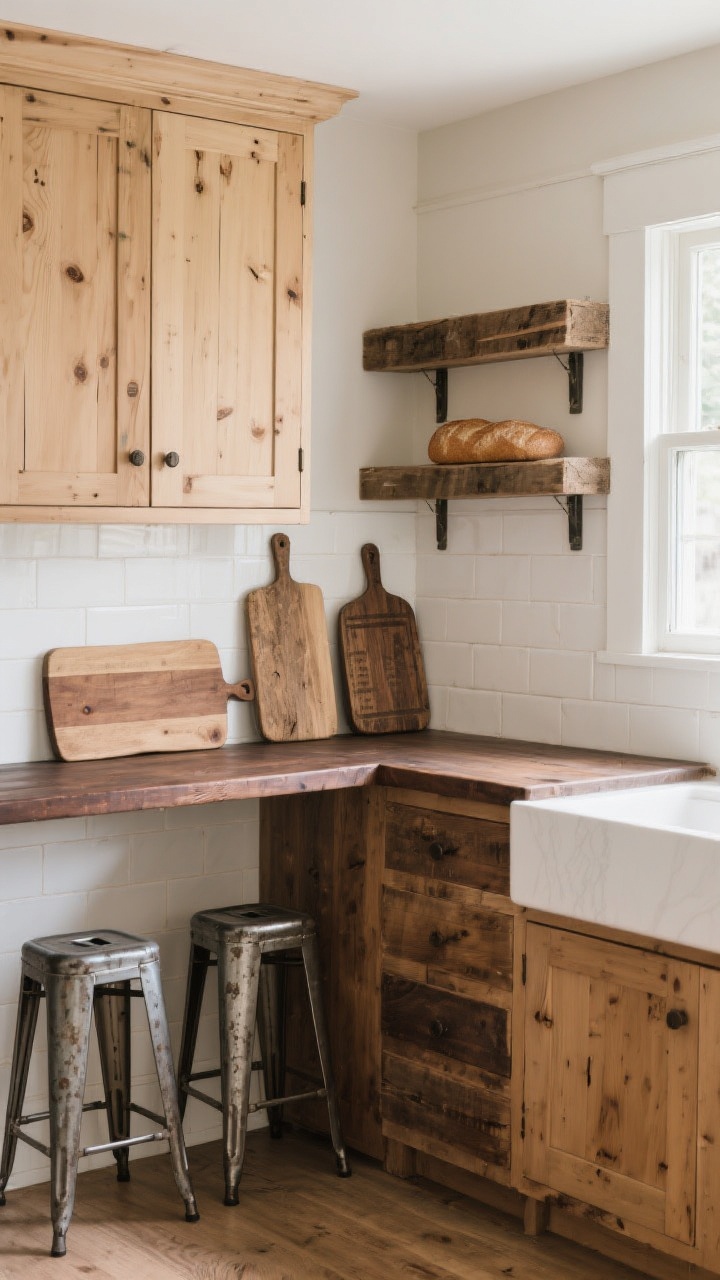
Nothing says farmhouse like wood with a story. Scratches? Character. A little uneven? Even better. The secret is mixing tones and grains without turning your kitchen into a lumberyard.
How To Nail the Wood Palette
- Pick a dominant tone: Warm oak, walnut, or reclaimed pine. Let that be your anchor on floors or cabinets.
- Add one contrasting wood: Maybe a darker walnut island with lighter oak cabinets—just one contrast keeps it balanced.
- Repeat the finish: If your shelves are matte and raw, echo that on a cutting board, stool legs, or a tray.
FYI: The farmhouse look thrives on real texture. If you can, choose solid wood or high-quality veneer over plastic laminates. Your kitchen will feel warmer and more grounded instantly.
Quick Wins
- Swap your modern bar stools for wood-and-metal stools with a worn finish.
- Add a butcher block cutting board as a permanent counter layer. Pretty and practical.
- Layer in a vintage bread board or two against the backsplash for height and depth.
2. Open Shelves That Don’t Stress You Out
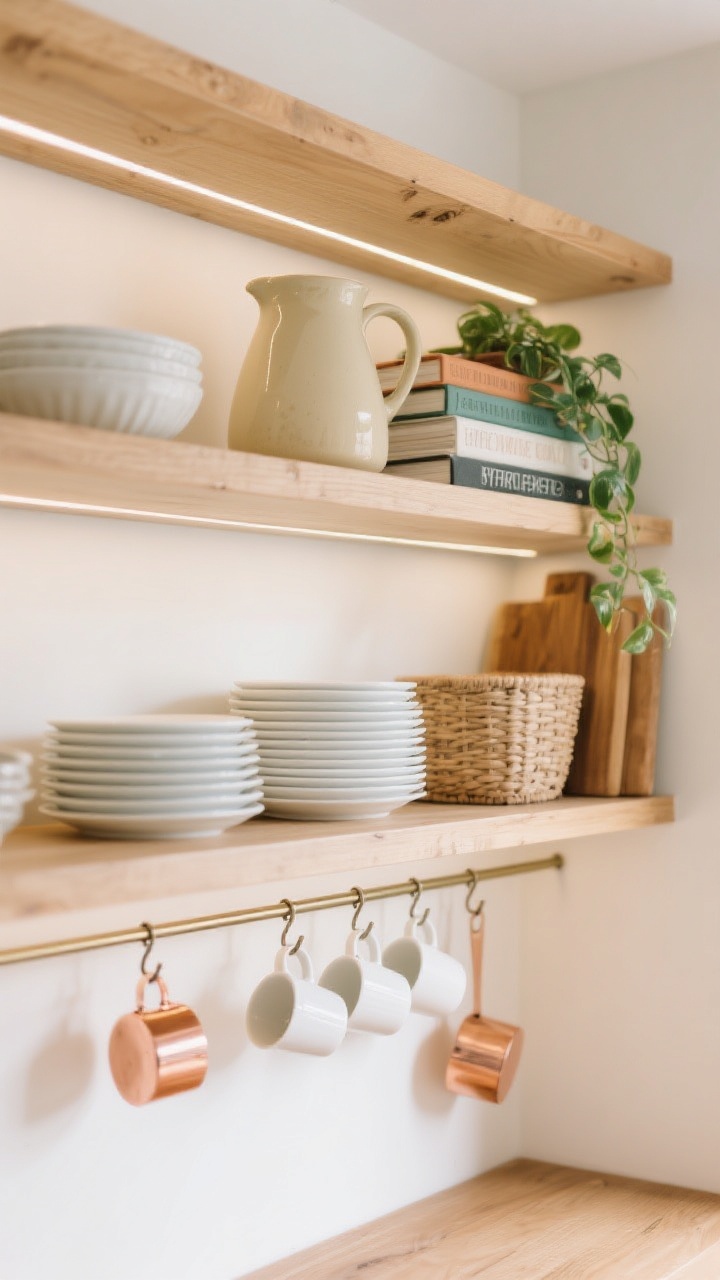
Open shelving is peak farmhouse—but it can go chaotic fast. The key? Treat shelves like mini displays with a tight color palette and useful pieces you reach for daily.
Styling That Actually Works
- Use a color story: Whites, creams, wood, and one accent like sage or navy. That’s it.
- Stack with purpose: Everyday plates and bowls on the lower shelf; pretty pitchers, cookbooks, and a plant up top.
- Vary heights and textures: Mix ceramic, glass, wicker, and wood for that layered, collected look.
And if you’re worried about dust? Keep your “show” items up high and your frequently used pieces down low. They get washed all the time anyway—so no dust drama.
Pro Move
- Install a thin rail under the bottom shelf with S-hooks for mugs or copper measuring cups.
- Add LED strip lighting under shelves for a warm glow that screams cozy bistro.
3. Go All-In on Natural Textures (It’s the Secret Sauce)
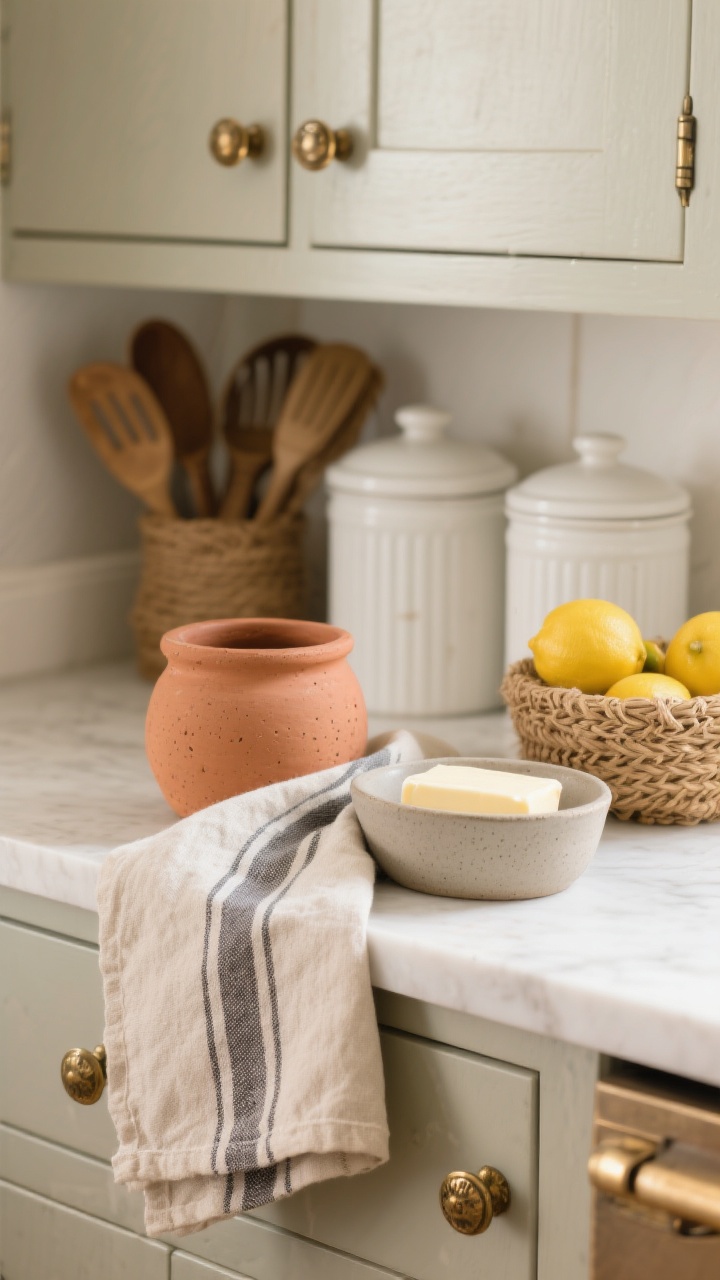
Rustic farmhouse thrives on tactile moments—the things you can feel. Even if your layout is modern, bring in linen, jute, stone, and clay to soften the edges.
Texture Touchpoints
- Soft goods: Linen tea towels, a chunky jute runner, or striped grain-sack cushions on stools.
- Counter accents: A terracotta utensil crock, a stoneware butter dish, and a woven fruit basket.
- Hardware and metals: Wrought iron or aged brass handles instantly warm up slick cabinets.
IMO, the fastest upgrade is swapping shiny chrome for antique brass or oil-rubbed bronze. It’s like giving your kitchen a cozy sweater.
Keep It From Feeling Heavy
- Balance heavier textures (like chunky baskets) with clean whites in dishes or canisters.
- Limit patterns to one hero: a striped runner or checkered curtains, not both.
4. Vintage Finds That Tell a Story (Without Becoming a Flea Market)
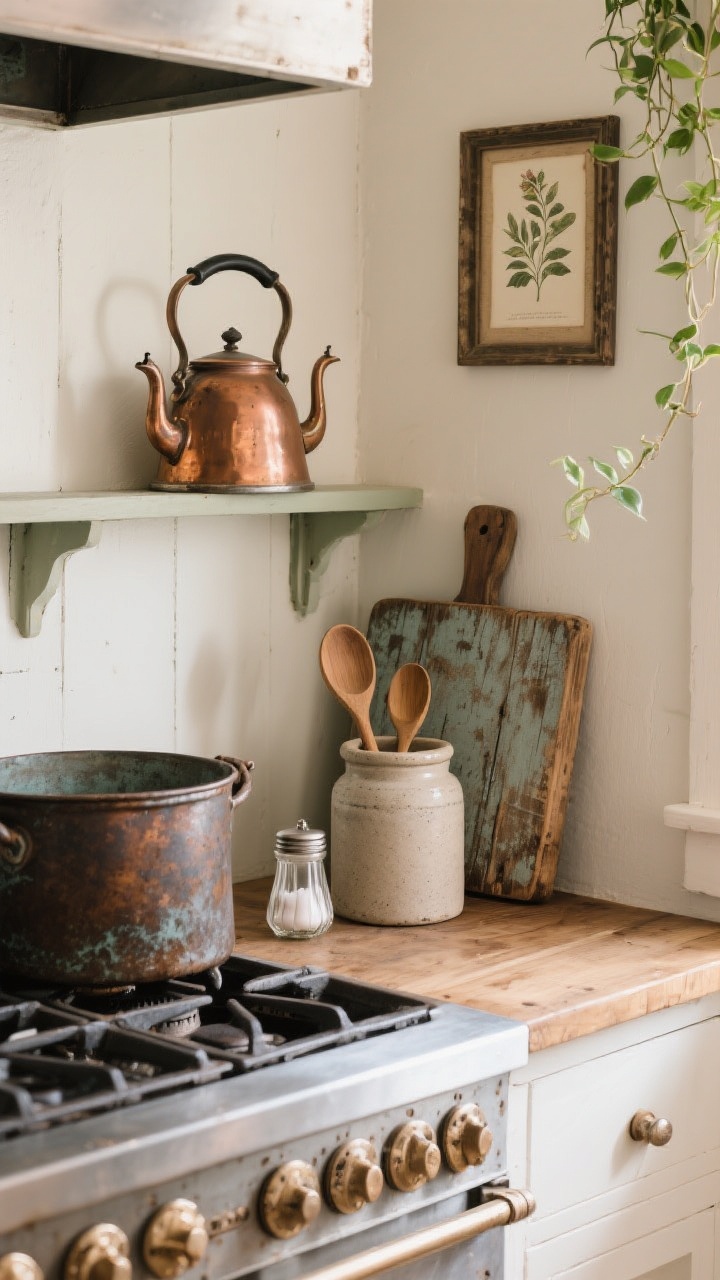
Those charming touches—an old scale, a copper kettle, a weathered bread tin—make your kitchen feel collected, not copied. But there’s a very thin line between curated and cluttered.
What to Hunt For
- Functional antiques: Stoneware crocks for utensils, enamel pitchers for flowers, wood crates for produce.
- Statement metals: Aged copper or galvanized pieces—just one or two so it doesn’t feel themed.
- Wall moments: Vintage bread boards, an old farm sign, or framed botanical prints.
Stick to one era vibe—lean French farmhouse or classic American barn—so everything feels intentional. Mix two or three special pieces in each zone and call it done. Editing is your best friend.
Smart Styling Spots
- By the stove: Vintage salt cellar, wooden spoon jar, small cutting board layered behind a pot.
- On the island: A low tray with a candle, olive oil decanter, and a tiny vase of herbs.
- Over the sink: A narrow shelf with a small framed print and a trailing plant.
5. Farmhouse Fixtures: Sinks, Faucets, and Lighting That Do the Heavy Lifting
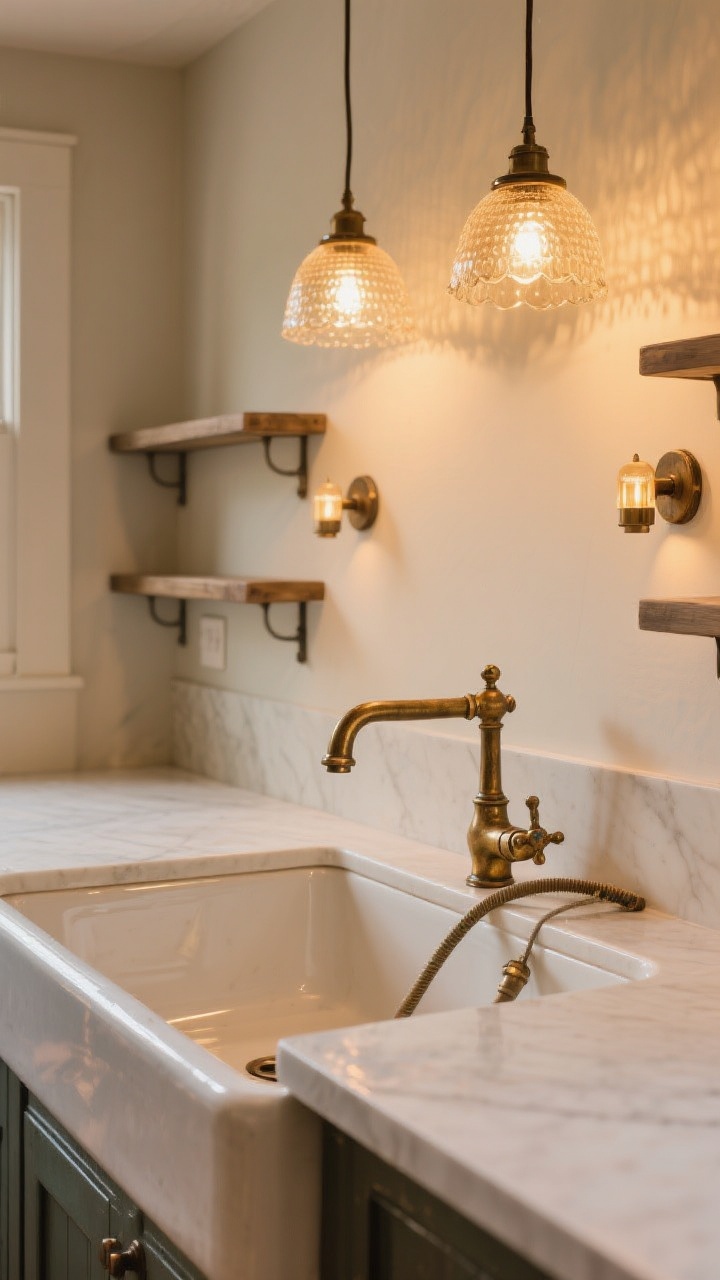
If you only upgrade a few things, make them the hard-working heroes. A farmhouse sink, a bridge faucet, and cozy pendant lighting can shift the whole mood.
Sink + Faucet Combos
- Apron-front sink: Iconic and functional. Fireclay is durable; cast iron brings vintage heft.
- Bridge faucet: Looks classic, works modern. Go with aged brass, matte black, or polished nickel.
- Sprayer option: A side sprayer or pull-down is worth it for daily cleanup.
Lighting That Sets the Scene
- Layered lighting: Combine warm pendants over the island, sconces by shelves, and a soft overhead.
- Materials that warm up: Seeded glass, linen shades, rattan, or metal with a patina.
- Bulb temperature: 2700K–3000K for that golden-hour glow (no hospital vibes, please).
Bonus: Add a dim switch on your main lights. Nighttime cleanup with a moody glow? Chef’s kiss.
6. Color, Backsplash, and Counters: Keep It Calm, Add Soul
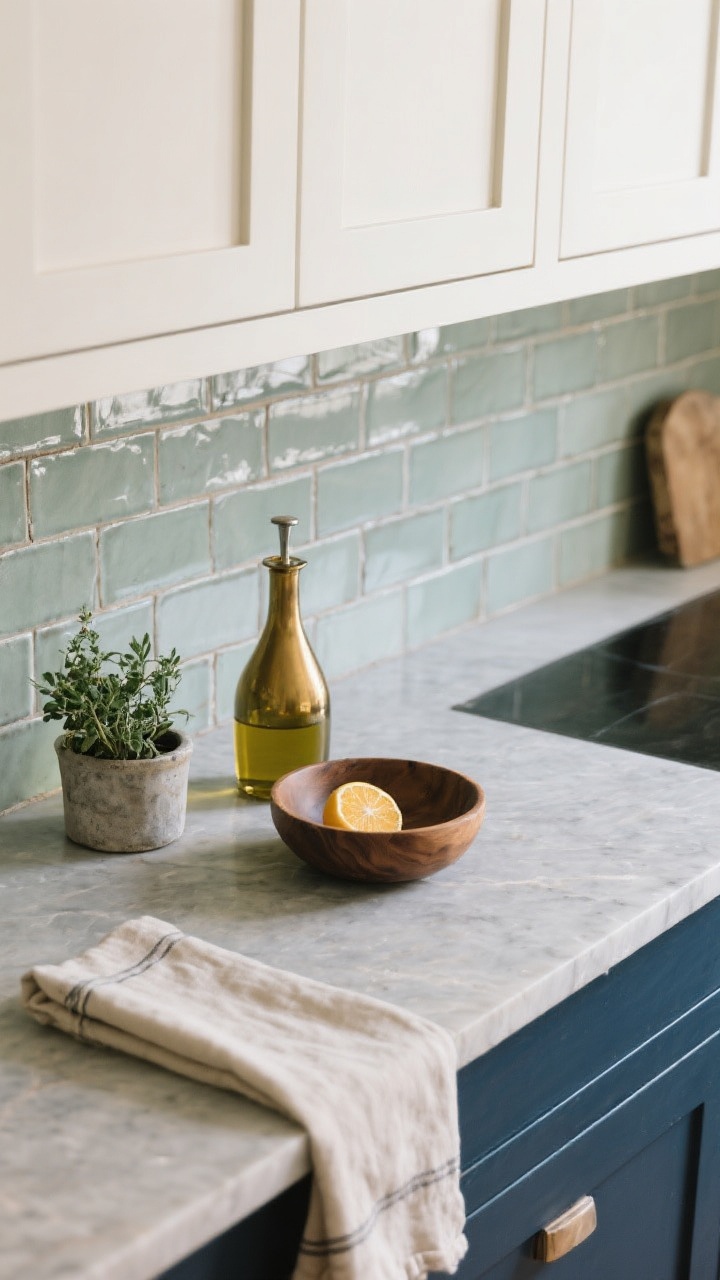
Farmhouse kitchens feel serene, not sterile. Keep your base palette soft and let materials shine. Think warm whites, soft grays, sage greens, or inky navy as your grounded tones.
Cabinet and Wall Colors
- Classic choices: Creamy white uppers with a deep green or navy island is forever stylish.
- Earthy neutrals: Mushroom, putty, or greige read timeless and pair beautifully with wood.
- Sheen matters: Satin or eggshell on walls; a durable satin on cabinets to keep things soft, not shiny.
Backsplash Ideas That Age Well
- Simple subway tile: Go handmade or zellige for texture; stack in a running bond with a soft gray grout.
- Beadboard or shiplap: Painted in a warm white for cozy cottage vibes. Seal it for kitchen life.
- Stone slab: A continuous marble or quartz backsplash feels luxe yet classic.
Countertop Pairings
- Butcher block: Warm and user-friendly. Oil it regularly and embrace the patina.
- Soapstone or honed granite: Matte, moody, and forgiving—perfect with brass and wood.
- Quartz (marble-look): If you want the look without the maintenance. Choose honed for authenticity.
Keep accents muted so your materials can breathe. A bowl of citrus, a vase of eucalyptus, and a linen runner will do more than a dozen tchotchkes.
Easy-to-Implement Styling Formula
- One living element (herbs, plant, or fresh flowers)
- One warm metal (brass, copper)
- One natural texture (wood, rattan)
- One soft textile (linen towel or runner)
That’s your instant rustic vibe—no overthinking required.
Maintenance Tips (So It Stays Cute)
- Patina control: Embrace small scuffs, but reseal wood counters and oil cutting boards monthly.
- Dust plan: Keep open shelves to a minimum and run a quick wipe weekly. It takes two minutes, promise.
- Edit seasonally: Swap in new stems, rotate textiles, and let a few pieces rest. Your kitchen will feel fresh year-round.
There you have it—six ways to turn your kitchen into a rustic farmhouse dream that still cooks dinner and hides the mail. Start with one zone (the sink, the island, or a shelf) and build from there. Small changes, big cozy energy. And yes, your friends will absolutely ask where you found that “old” bread board. You can tell them it’s vintage… or just wink. Your secret’s safe with me.
